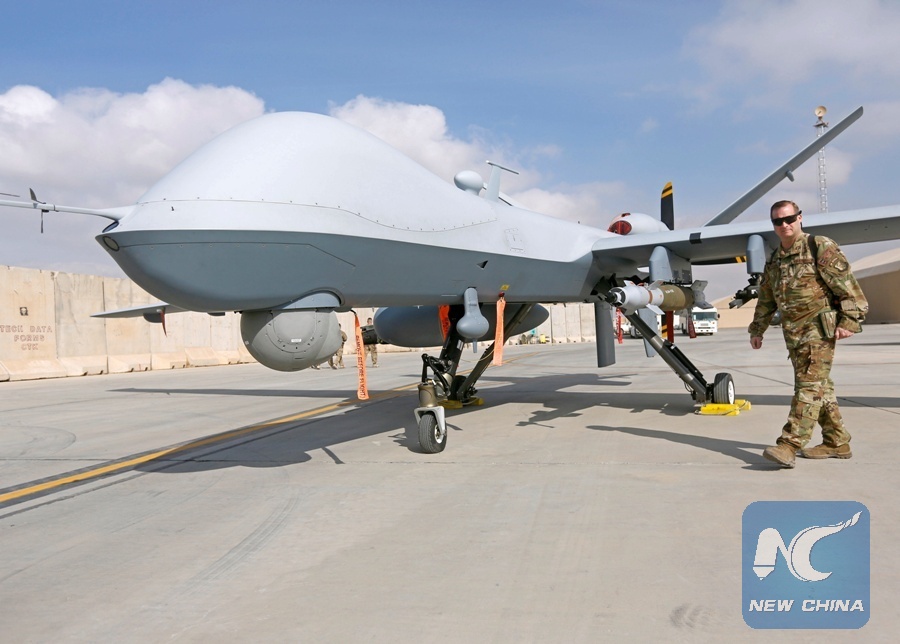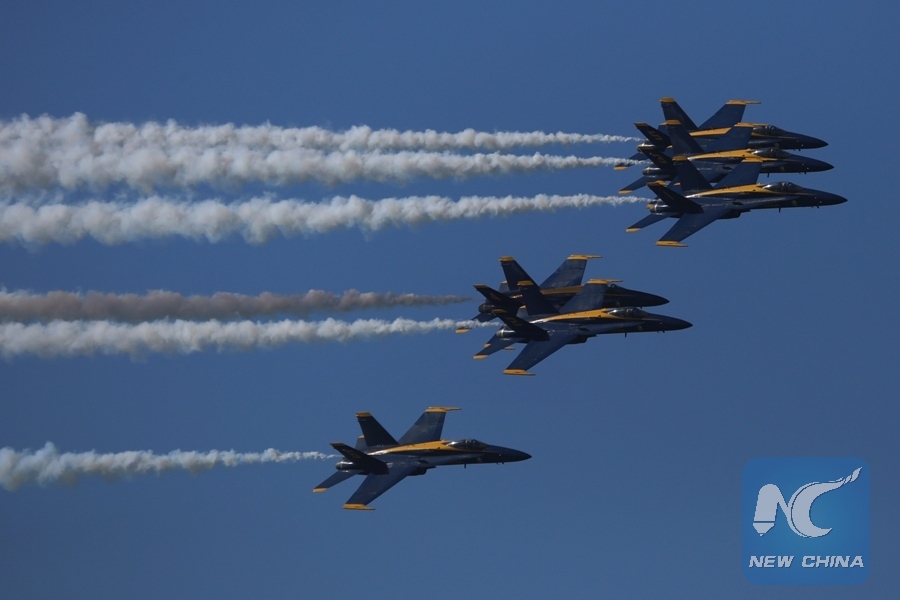
A soldier patrols on USS Gerald R. Ford before its commissioning ceremony at Naval Station Norfolk, Virginia, the United States, on July 22, 2017. (Xinhua/Yin Bogu)
WASHINGTON, Feb. 14 (Xinhua) -- The U.S. Department of Defense (DoD) on Monday rolled out its budget for fiscal year 2019, asking Congress for 716 billion U.S. dollars for arms purchases and a staff expansion, and bringing a slew of questions and doubts.
The entire budget consists of three parts -- the base budget of 617 billion U.S. dollars, covering Pentagon operation costs and arms procurement, the war fund, or Overseas Contingency Operations, of 69 billion dollars, and the defense budget of 30 billion dollars to keep other government agencies functioning.
This marks the first time that the Pentagon base budget has topped 600 billion dollars in recent years, a 10 percent increase from the current spending approved by Congress.
The Army will receive about 143 million dollars, the Navy will get 179 million, the Air Force will receive 169 million and DoD agencies, 105 million.

U.S. Air Force officer passes in front of a MQ-9 Reaper drone, one of a squadron that has arrived to step up the fight against the Taliban, at the Kandahar air base, Afghanistan Jan. 23, 2018. (Xinhua/REUTERS)
The money would be above all invested in the recruitment of another 25,900 military personnel by the end of the fiscal year 2019, and offer a 2.6 percent rise in their payment, a record high in the past nine years.
For different services, the Air Force will gain 4,000 active duty forces with the staff scale increasing to 329,100, roughly by one percent. The Navy will gain almost 7,500 ones, with the troop size up to 335,400, or two percent increase. The Marine Corps will gain 1,100 active duty forces, with the size increasing to 186,100, or a one percent increase. And the Army will gain 11,500 members, bringing its number to 487,500 or two percent.
The National Guard and other reserve military forces will have a modest growth. The budget has also laid out its plans for a hardware update.
For aircrafts, the budget plans to buy 77 F-35 strike fighter jets, 60 Apache attack helicopters, 15 KC-46 tankers and 24 F-18 Super Hornets. For shipbuilding, the plan will spend 7.4 billion dollars on two Virginia Class Submarines, six billion dollars on three Arleigh Burke Class Destroyers, and 1.3 billion dollars on one Littoral Combat ship.

The U.S. Navy Blue Angels fly over the Golden Gate Bridge in an air show of the annual Fleet Week activities in San Francisco, the United States, on Oct. 7, 2017. (Xinhua/Liu Yilin)
The plan also sets aside 4.3 billion dollars for space equipment, 4.6 billion on munition, 5.8 billion on ground systems, 6.9 billion on nuclear deterrence and 6 billion on missile defense programs.
Speaking at a press conference on Monday, Comptroller of the Pentagon David Norquist said the proposal was drafted in accordance with the National Defense Strategy and the National Security Strategy that focused on "great power competition."
Norquist said the Pentagon was pleased that Congress has voted to raise the caps on defense spending and end sequestration, which he said was essential for U.S. military to "climb out of a hole."
The budget, pending approval from Congress, is one of the few in the collective federal budgets released by the White House, increasing defense expenditures from last year. By contrast, budgets for many welfare programs and government agencies saw steep cuts.

A soldier from the 3rd U.S. Infantry Regiment places flags at grave sites during the "Flags-In" ceremony at the Arlington National Cemetery in Arlington, Virginia, the United States, on May 25, 2017. (Xinhua/Yin Bogu)
Norquist said military spending requested in the budget represent quite a low percentage of the GDP of the United States since World War II. However, considering the national budget of 4.4 trillion dollars, more than 16 percent of the country's budget will be spent on defense, still a huge figure.
While the budget proposal was widely anticipated, the U.S. media and analysts nevertheless expressed dismay at the seemingly insatiable appetite of the Pentagon.
Right wing media the American Conservative said those who stand to gain the most from a fat defense budget are military contractors, but not necessarily the U.S. security force.
Liberal media Slate Magazine said the generous budget came at the expense of steep cuts in other agencies, dubbing the budget "all guns and no butter."
Michael Klare, an expert at Arms Control Association, told Xinhua that even though the United States can afford to support a strong military, reducing taxes and pledging ambitious infrastructure investment in the same time are recipes for a mushrooming deficit.
"Increased military spending will further contribute to a ballooning deficit, and that is not sustainable over time. Eventually, it will lead to higher borrowing costs and rising inflation, with unforeseeable economic consequences," he said.
Klare said he was not convinced of the premise of the budget that the United States is entering an era of great power competition, saying it is not necessary for the country to "assume that a new Cold War with both China and Russia is inevitable and so (Washington) must prepare for all-out war with both of them when there are many areas where cooperation remains possible."

